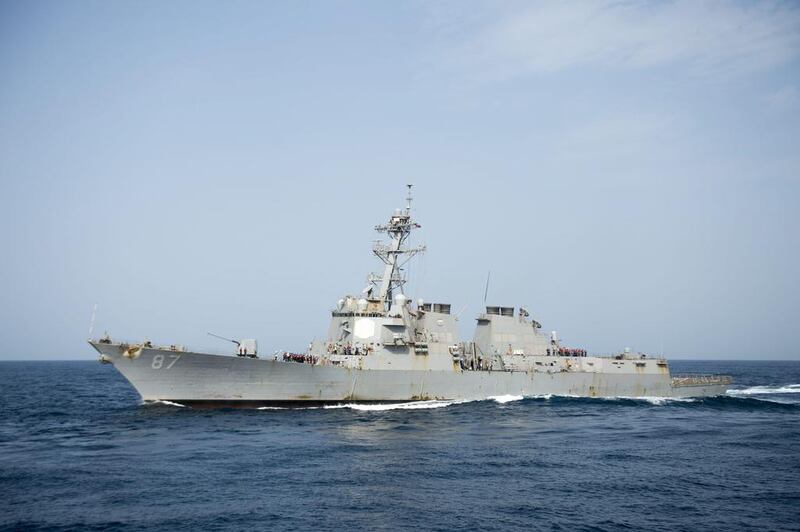ABU DHABI // A US warship was fired at from Houthi-held territory in Yemen on Wednesday for the second time in four days.
The USS Mason, which was accompanied by the USS Ponce, fired defensive shots at the missiles, neither of which hit the ship as it patrolled north of the Bab Al Mandeb strait.
On Sunday another two missiles were fired at the USS Mason, a guided missile destroyer. The US warship shot down the first while the second, launched an hour later, fell short.
Last week a missile, again fired from territory held by the Yemeni rebels, struck a UAE civilian aid ship, the Swift, causing extensive damage and injuring crew members.
A US defence department spokesman confirmed on Tuesday that the missiles fired on Sunday came from coastal territory held by the Houthis and would not rule out the possibility that the weapons system was provided by Iran.
“It’s no secret that Iran has been actively supplying them and giving them the tools of war,” said Pentagon spokesman Capt Jeff Davis.
The United States is providing support to the Saudi-led coalition that is fighting the Shiite rebels in Yemen, including aerial refuelling of fighter jets, intelligence and logistics.
Since the breakdown of peace negotiations between the Houthis and the internationally-recognised Yemeni government in August, the conflict in Yemen has escalated sharply and pushed the humanitarian situation to the brink of catastrophe.
The rebels and allied soldiers loyal to former president Ali Abdullah Saleh have increased their missile attacks and ground incursions across the border of Saudi Arabia.
Late on Tuesday Riyadh intercepted a ballistic missile fired by Houthi forces targeting an airbase near the border with Yemen.
The missile, which was fired from rebel-held territory into the city of Khamis Mushayt, was destroyed by the Saudi royal air defence forces without causing any damage or injuries, said the state Saudi Press Agency (Spa).
Saudi jets later targeted the alleged launch site, it added.
The Houthis – who are supported by Iran – said on Twitter that their intended target was the King Faisal airbase, which is located about 40 kilometres north of the border with Yemen.
It comes after a missile fired by the rebels on Saturday reportedly landed near a Saudi military base in Taif, a city in Mecca province – the farthest target yet from the border – and after two missiles were fired into the border province of Jizan on Monday, injuring two people.
On Wednesday, pro-government media said loyalist Yemeni fighters were advancing across the Saudi border into the Houthi stronghold of Saada governorate and towards its capital.
The forces are primarily made up of fighters loyal to the Salafist leader Bassam Al Mehbar, who had previously been fighting the rebels in the country’s south. The fighters were transported to the kingdom’s southern border for the offensive by the coalition.
The latest Houthi – and suspected Houthi – attacks – are thought to be in retaliation for the alleged bombing of a funeral in Sanaa on Saturday by Saudi warplanes. More than 140 people were killed and hundreds more wounded at the funeral for the father of a Houthi political leader, which was attended by a number of senior rebel figures.
Riyadh has promised an investigation into what it said was a “regrettable and painful” incident. Spa reported that a letter was sent to the UN Security Council that “expressed the kingdom’s deep regret”.
King Salman on Wednesday ordered Saudi aid officials to work with the Yemeni government and coalition “to facilitate the evacuation of those wounded and needing treatment abroad”, according to Spa, indicating an easing of the coalition’s air and sea blockade. More than 300 of the wounded are reportedly in critical condition.
Riyadh is facing increasing criticism in western capitals over its air campaign on Yemen, and the White House on Monday announced an “immediate review” of its support for the coalition.
But the US may take direct action in the conflict in retaliation for the attempted missile attacks on its ship. American officials said on Tuesday that they were still investigating Sunday’s attack and considering how to respond.
“Counter-strike, retaliatory strike: I can tell you that those things are things that we are looking at,” Capt Davis said. “We will make sure that anybody who interferes with freedom of navigation or anybody who puts US navy ships at risk understands that they do so at their own peril.”
The Bab Al Mandab is a choke point for around 40 per cent of global commercial shipping traffic, mostly transiting in both directions through the Suez Cana, including four million barrels of oil daily.
While the US investigation has not concluded definitively that the Houthis were responsible for Sunday’s attempted missile attack, the rebels “have said publicly before that they would target any ships in that area that were supporting the coalition against them”, the spokesman said. “So the facts certainly seem to point to it.”
The Houthis reportedly denied firing the missiles at the US ship on Sunday, but have claimed responsibility for the attack on the UAE vessel.
tkhan@thenational.ae
* Additional reporting by Reuters and Agence France-Presse





